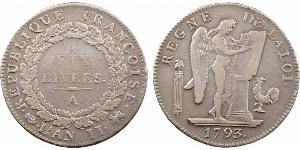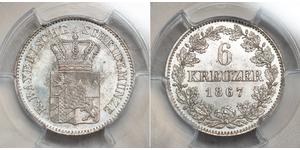1 Ecu (Vendida por $62.0)
1783, Royal France, Louis XVI. Silver Ecu (French Dollar) Coin. Bearn mint!
Mint year: 1783 Denomination: Ecu (French Dollar) Privy Mark: scepter with hand of justice Mint Place: Province of Bearn (BD) / Pau References: Davenport 1334, Gadoury 356a, KM-572. Mint Director: Michel Soulon (1777-1789, privy mark: hand of justice) Local Engraver: Pierre Joseph Duvivet (1759-1794, privy mark: sheaf of wheat) Condition: Weight adjusting marks, light deposits and a few scratches, otherwise a nice VF+ Weight: 29.17gm Diameter: 41mm Material: Silver
Obverse: Head of Louis XV left, privy mark (privy mark: scepter with hand of justice) below. Legend: LUD . XVI . D . G . FR . . ET . NA . RE . BD . Reverse: Crown above oval with three fleur de lis inside, flanked by olive branches. Legend: SIT NOMEN . DOMINI (privy mark: cow) BENEDICTUM (privy mark: sheaf of wheat) 1783 .
The viscountcy of Bearn (Gascon: Bearn or Biarn) is a former province of France, located in the Pyreneesmountains and in the plain at their feet, in southwest France. Along with thethree Basque provinces of Soule, Lower Navarre, and Labourd, as well as small parts of Gascony, it forms the current departement of Pyrenees-Atlantiques (64).
Bearn is bordered by Basque provinces Soule and Lower Navarre to the west, by Gascony (Landes and Armagnac) to the north, by Bigorre to the east, and by Spain (Aragon) to the south.
Although Bearn was included in the original borders of France as established by the Treaty of Verdun in 843, its inclusion in the kingdom was controversial. Its first parliamentary body, the Cour Major, was formed in 1080, 185 years before England's parliament. Bearn became a part of the Duchy of Aquitaine, which passed to the Kings of England through Eleanor of Aquitaine, and was thus subject to the Kingdom of England for a little over a century (1242-1347). Bearn passed to the county of Foix in 1290; in 1347 Count Gaston III Febus paid homage to the king for his own county, but refused to give homage for Bearn, which he claimed as an independent fief, with its chief seat his stronghold at Pau, a site that had been fortified by the 11th century, which was made the official capital the seat of Bearn Province in 1464. Later, the territory passed through heiresses to the Kingdom of Navarre (see below), and this inclusion in a foreign state (though ruled by descendants of the French Capetian dynasty) contributed to its doubtful relationship to the Kingdom of France.
Eventually, Bearn fell to Henry III of Navarre, who inherited it from his mother, while at the same time the Kingdom of Navarre was almost entirely annexed by Spain (with only Lower Navarre, north of the Pyrenees, not annexed by Spain). Henry III of Navarre became King Henry IV of France in 1589, but he kept all his estates distinct from France. It was only in 1607 that he conceded to the demands of the Parlement of Paris, and reunited with the French crown his domains of County of Foix, Bigorre, Quatre-Vallees, and Nebouzan, conforming to the tradition that the king of France would have no personal domain. However, he refused to unite Bearn and Lower Navarre with the French crown, since these territories were sovereign countries, not formally under French sovereignty like Foix, Bigorre, and his other estates.
Thus Bearn and Lower Navarre remained only in a personal union with France (i.e. united to France through the person of Henry, both King of France and King of Navarre). It was only in 1620, ten years after his death, that Bearn and Lower Navarre were united to the French crown and entered French sovereignty, but the title of King of Navarre was kept by the kings of France until 1830.
Previously, in 1539, the Edict of Villers-Cotteret had ordained that laws would be enacted in French (to the detriment of Latin and smaller local languages), but Bearn was not yet part of France and the edict did not apply there. Instead, after its incorporation into France, laws continued to be enacted in the langue d'oc until the French Revolution.
em>.
Louis XVI or Louis-Auguste de France (Versailles, 23 August 1754 - Paris, 21 January 1793) ruled as King of France and of Navarre from 1774 until 1791, and then as King of the French from 1791 to 1793. Suspended and arrested during the Insurrection of 10 August, he was tried by the National Convention, found guilty of treason, and executed by guillotine on 21 January 1793. He was the only king of France to be executed.
Although Louis was beloved at first, his indecisiveness and conservatism led some elements of the people of France to eventually view him as a symbol of the perceived tyranny of the Ancien Regime. After the abolition of the monarchy in 1793, the new republican government gave him the surname Capet, a reference to the nickname of Hugh Capet, founder of the Capetian dynasty, which the revolutionaries wrongly interpreted as a family name. He was also informally nicknamed Louis le Dernier (Louis the Last), a derisive use of the traditional nicknaming of French kings. Today, historians and French people in general have a more nuanced view of Louis XVI, who is seen as an honest man with good intentions, but who was probably unfit for the herculean task of reforming the monarchy, and who was used as a scapegoat by the revolutionaries.

|
Publicado por:
anonymous 2017-01-01 |
|
||
|
||
|
||
|
||
|
||
6 Kreuzer Reino de Baviera (1806 - 1918) Plata Luis II de Ba ...
grupo tiene 2 monedas
⇑

-600-300-M10KX9ISeoIAAAFZzHPtA1ie.jpg)

-300-150-QjkKbzbivRIAAAFPuxKA8Ieb.jpg)
 Deutsch
Deutsch Русский
Русский Українська
Українська English
English Italiano
Italiano Français
Français Español
Español 汉语
汉语






-300-150-cVAhwJflFy0AAAGLltZTnYLB.jpg)






